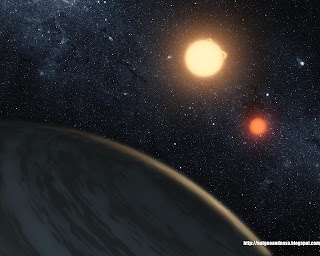In the Light of Two Suns
This artist's concept illustrates Kepler-16b, the first planet known to definitively orbit two stars -- what's called a circumbinary planet. The planet, which can be seen in the foreground, was discovered by NASA's Kepler mission.The two orbiting stars regularly eclipse each other, as seen from our point of view on Earth. The planet also eclipses, or transits, each star, and Kepler data from these planetary transits allowed the size, density and mass of the planet to be extremely well determined. The fact that the orbits of the stars and the planet align within a degree of each other indicate that the planet formed within the same circumbinary disk that the stars formed within, rather than being captured later by the two stars.
Credit: NASA/JPL-Caltech/T. Pyle

No comments:
Post a Comment